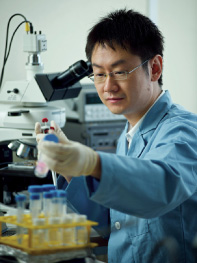Impact of Microfluidic lab-on-chip Studies on Biotechnology and Medicine

Dr Liu Yang from CE Programme in action
A CE research team comprising research assistant Liu Yang and his supervisor, Assoc Prof Lim Kian Meng has completed a study of a bi-fluid micro-flow system that separates particles from its original solvent and re-dilutes them into another solvent simultaneously.
This particle transport methodology is a significant extension of previous acoustic particle separation methods, which were performed within a single fluid. One major advantage of the team's study is that it has managed to combine the initially separate processes of particle separation and re-dilution into a single step. This simplifies the process of cell preparation, resulting in less complex lab-on-chip (LOC) systems. LOC is a device that deals with the handling of extremely small fluid volumes. It integrates one or several laboratory functions on a single chip measuring millimetre to a few square centimetre in size.
Notably, this methodology provides a wide application potential, especially for cell separation integrated in LOC systems where aquatic dilutions are commonly used. One example of this is in the medical industry, where the method may be used to separate infected blood cells from the healthy cells based on their different mechanical properties.
